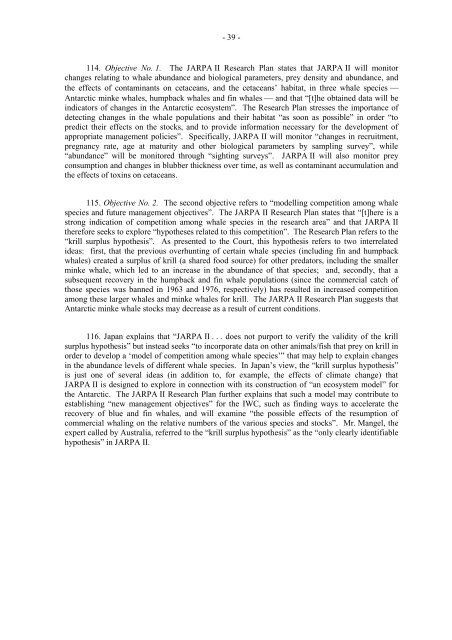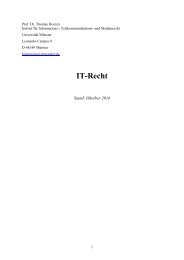3d4yVkKMl
3d4yVkKMl
3d4yVkKMl
Create successful ePaper yourself
Turn your PDF publications into a flip-book with our unique Google optimized e-Paper software.
- 39 -<br />
114. Objective No. 1. The JARPA II Research Plan states that JARPA II will monitor<br />
changes relating to whale abundance and biological parameters, prey density and abundance, and<br />
the effects of contaminants on cetaceans, and the cetaceans’ habitat, in three whale species<br />
Antarctic minke whales, humpback whales and fin whales and that “[t]he obtained data will be<br />
indicators of changes in the Antarctic ecosystem”. The Research Plan stresses the importance of<br />
detecting changes in the whale populations and their habitat “as soon as possible” in order “to<br />
predict their effects on the stocks, and to provide information necessary for the development of<br />
appropriate management policies”. Specifically, JARPA II will monitor “changes in recruitment,<br />
pregnancy rate, age at maturity and other biological parameters by sampling survey”, while<br />
“abundance” will be monitored through “sighting surveys”. JARPA II will also monitor prey<br />
consumption and changes in blubber thickness over time, as well as contaminant accumulation and<br />
the effects of toxins on cetaceans.<br />
115. Objective No. 2. The second objective refers to “modelling competition among whale<br />
species and future management objectives”. The JARPA II Research Plan states that “[t]here is a<br />
strong indication of competition among whale species in the research area” and that JARPA II<br />
therefore seeks to explore “hypotheses related to this competition”. The Research Plan refers to the<br />
“krill surplus hypothesis”. As presented to the Court, this hypothesis refers to two interrelated<br />
ideas: first, that the previous overhunting of certain whale species (including fin and humpback<br />
whales) created a surplus of krill (a shared food source) for other predators, including the smaller<br />
minke whale, which led to an increase in the abundance of that species; and, secondly, that a<br />
subsequent recovery in the humpback and fin whale populations (since the commercial catch of<br />
those species was banned in 1963 and 1976, respectively) has resulted in increased competition<br />
among these larger whales and minke whales for krill. The JARPA II Research Plan suggests that<br />
Antarctic minke whale stocks may decrease as a result of current conditions.<br />
116. Japan explains that “JARPA II . . . does not purport to verify the validity of the krill<br />
surplus hypothesis” but instead seeks “to incorporate data on other animals/fish that prey on krill in<br />
order to develop a ‘model of competition among whale species’” that may help to explain changes<br />
in the abundance levels of different whale species. In Japan’s view, the “krill surplus hypothesis”<br />
is just one of several ideas (in addition to, for example, the effects of climate change) that<br />
JARPA II is designed to explore in connection with its construction of “an ecosystem model” for<br />
the Antarctic. The JARPA II Research Plan further explains that such a model may contribute to<br />
establishing “new management objectives” for the IWC, such as finding ways to accelerate the<br />
recovery of blue and fin whales, and will examine “the possible effects of the resumption of<br />
commercial whaling on the relative numbers of the various species and stocks”. Mr. Mangel, the<br />
expert called by Australia, referred to the “krill surplus hypothesis” as the “only clearly identifiable<br />
hypothesis” in JARPA II.



